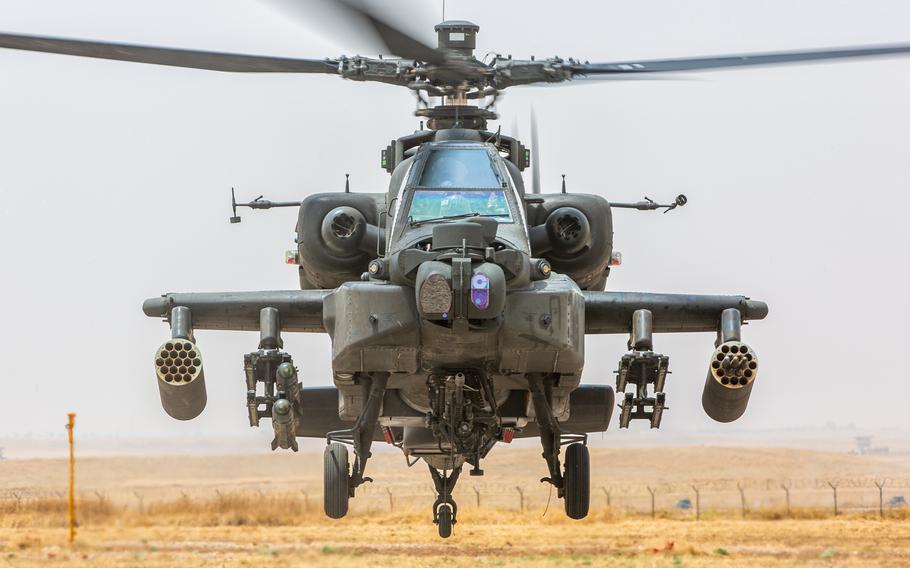
An AH-64D Apache Longbow attack helicopter takes off for a mission in July 2024 at Irbil Air Base in Iraq. (Joseph Kumza/U.S. Army)
Our military is in a time of transition. The future of warfare is changing rapidly, as is military technology. While we prepare and invest in what may come, we must also maintain our defenses for the threats facing our nation today and be ready to fight tonight. That can make defense acquisitions uniquely challenging for our services.
The future of our military rotorcraft fleet is a particular concern, especially for the Army. After canceling its plans for the Future Attack Reconnaissance Aircraft (FARA), many observations from the current conflict in Ukraine and with high demand for attack capability from foreign allies in many potential conflict areas, there are questions about what the Army’s future attack portfolio should look like. Unfortunately, there is no longer time to kick the can down the road. The Army needs to decide on its path forward, and it must do it soon.
Over the past two decades, the Army has canceled four major helicopter programs. The starting and stopping of programs indicates a lack of direction at a time when a clear vision is vitally important. The good news is that the Army has a capable attack helicopter in its inventory that can be modernized cost-effectively rather than designing a brand-new aircraft at substantial cost to American taxpayers.
The AH-64 Apache has been a critical program to the Army in nearly every military conflict since becoming operational in the early 1980s. Its capabilities include surveillance, reconnaissance, strike, and close air support. It’s performed missions in Panama, Desert Shield, Desert Storm, Iraqi Freedom, and Enduring Freedom Afghanistan to name a few. The Apache also has a long list of international operators because it is the most capable and cost-effective attack helicopter in the free world.
Further, the Apache is the Army’s elite attack helicopter. The newest “Echo” model of the Apache is lighter and faster than its predecessors. It has advanced manned-unmanned teaming and gives pilots the ability to control drones from the cockpit, which makes target acquisition and attack much more efficient. The new Echo model can also destroy drones, tanks and other targets from up to eight kilometers, and provide overwatch for ground troops in all terrains and weather conditions.
The Army has had these capabilities available to enhance its helicopter fleet but has deferred making a concrete decision on what the future of its attack capability will look like. It can no longer hedge its bets because the Apache remanufacture program is dangerously close to shutting down. If that happens, the Army will lose a critical government/industrial team across the country, honed over decades of designing, building, testing and supporting this uniquely lethal and cost-effective capability.
The Army is at a fork in the road. I believe it should choose one path -- request Congress to fund the addition of Apache helicopters to bolster its current fleet during this transition period and keep the remanufacturing line open. It can also prioritize the modernization of its current Apache fleet. There are still many “Delta” model Apaches in the skies -- upgrading to the Echo model will not only give the fleet essential new technologies and capabilities, but it will also extend a critical government/industry capability. This unique opportunity is a way to convert worn airframes into new modern capability for our warfighters. By reusing key high-price components like engines, sensors and subsystems, it is the best decision for the taxpayer and the warfighter.
That is the financially prudent measure for the Army as it maps out its plans for the 2030’s and beyond. That could include research and development for the next version of the Apache. An Apache “Foxtrot” model would undoubtedly deter any enemy that had the misfortune of seeing it on the horizon today, tomorrow and into the 2030s.
If the Army takes the second option — do nothing — the Apache remanufacture production line for the Army will shut down in 2028 with no immediate replacement. Once the line stops, it’s nearly impossible for it to start again if the Army changes its mind to upgrade its remaining Delta models, which are twice the cost to operate as Echo models. It will also complicate that ability to upgrade the fleet to the Foxtrot. It will also likely lead to shortages of spare parts in the coming years, causing maintenance issues for mechanics and flight crews.
Military leaders are currently putting together priority lists to submit to Congress prior to funding discussions in the upcoming National Defense Authorization Act and defense appropriations. This is the year the Army must seriously consider the future of its helicopter fleet. If it stands still, it will lose the critical Apache program, leaving significant capability gaps in the defense operations of America and our allies.
Prioritizing investments in future Apache technology upgrades in the next budget will signal the Army’s commitment to safety, capability and modernization for the future fight. We must encourage our military leaders to make the correct decision.
David Koopersmith is an aeronautical engineer with over 40 years of experience in engineering, production operation, supply chain, sales, and program management. He has acted as general manager for the Department of Defense and allies around the globe and is the former chairman of the Board of the Vertical Flight Society, the world’s oldest and largest technical society dedicated to enhancing the understanding of vertical flight technology. He was an executive for Boeing overseeing Attack Helicopter Programs and the Vertical Lift Division.